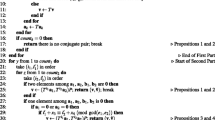Abstract
We propose a construction of de Bruijn sequences by the cycle joining method from linear feedback shift registers (LFSRs) with arbitrary characteristic polynomial f(x). We study in detail the cycle structure of the set \(\varOmega (f(x))\) that contains all sequences produced by a specific LFSR on distinct inputs and provide a fast way to find a state of each cycle. This leads to an efficient algorithm to find all conjugate pairs between any two cycles, yielding the adjacency graph. The approach is practical to generate a large class of de Bruijn sequences up to order \(n \approx 20\). Many previously proposed constructions of de Bruijn sequences are shown to be special cases of our construction.
Similar content being viewed by others
References
Broder A.: Generating random spanning trees. In: Proceedings of 30th Annual Symposium on Foundations of Computer Science, pp. 442–447 (1989).
Bruckstein A.M., Etzion T., Giryes R., Gordon N., Holt R.J., Shuldiner D.: Simple and robust binary self-location patterns. IEEE Trans. Inf. Theory 58(7), 4884–4889 (2012).
Chang Z., Ezerman M.F., Ling S., Wang H.: The cycle structure of LFSR with arbitrary characteristic polynomial over finite fields. Cryptogr. Commun. (2017) (Online First 20 Dec 2017). https://doi.org/10.1007/s12095-017-0273-2.
Chang Z., Ezerman M.F., Ling S., Wang H.: Construction of de Bruijn sequences from product of two irreducible polynomials. Cryptogr. Commun. 10(2), 251–275 (2018).
de Bruijn N.G.: A combinatorial problem. Koninklijke Nederlandse Akademie v. Wetenschappen 49, 758–764 (1946).
Ding C., Pei D., Salomaa A.: Chinese Remainder Theorem: Applications in Computing, Coding Cryptography. World Scientific Publishing, River Edge (1996).
Etzion T., Lempel A.: Algorithms for the generation of full-length shift-register sequences. IEEE Trans. Inf. Theory 30(3), 480–484 (1984).
Ezerman M.F., Fahreza A.A.: A binary de Bruijn sequence generator from product of irreducible polynomials. https://www.github.com/adamasstokhorst/debruijn.
Fredricksen H.: A class of nonlinear de Bruijn cycles. J. Combin. Theory Ser. A 19(2), 192–199 (1975).
Fredricksen H.: A survey of full length nonlinear shift register cycle algorithms. SIAM Rev. 24(2), 195–221 (1982).
Golomb S.W.: Shift Register Sequences. Aegean Park Press, Laguna Hills (1981).
Golomb S.W., Gong G.: Signal Design for Good Correlation: for Wireless Communication, Cryptography, and Radar. Cambridge University Press, New York (2004).
Hauge E.R., Helleseth T.: De Bruijn sequences, irreducible codes and cyclotomy. Discret. Math. 159(1–3), 143–154 (1996).
Hauge E.R., Mykkeltveit J.: On the classification of de Bruijn sequences. Discret. Math. 148(13), 65–83 (1996).
Hemmati F., Schilling D.L., Eichmann G.: Adjacencies between the cycles of a shift register with characteristic polynomial \((1+x)^{n}\). IEEE Trans. Comput. 33(7), 675–677 (1984).
Knuth D.E.: Grayspspan. http://www-cs-faculty.stanford.edu/~uno/programs/grayspspan.w.
Knuth D.E.: The Art of Computer Programming. Seminumerical Algorithms, vol. 2, 3rd edn. Addison-Wesley/Longman Publishing, Boston (1997).
Knuth D.E.: The Art of Computer Programming, vol. 4A, Combinatorial Algorithms. Part 1. Addison-Wesley, Upple Saddle River (2011).
Kurosawa K., Sato F., Sakata T., Kishimoto W.: A relationship between linear complexity and k-error linear complexity. IEEE Trans. Inf. Theory 46(2), 694–698 (2000).
Li M., Lin D.: The adjacency graphs of LFSRs with primitive-like characteristic polynomials. IEEE Trans. Inf. Theory 63(2), 1325–1335 (2017).
Li M., Lin D.: De Bruijn sequences, adjacency graphs and cyclotomy. IEEE Trans. Inf. Theory 64(4), 2941–2952 (2018).
Li C., Zeng X., Helleseth T., Li C., Hu L.: The properties of a class of linear FSRs and their applications to the construction of nonlinear FSRs. IEEE Trans. Inf. Theory 60(5), 3052–3061 (2014).
Li C., Zeng X., Li C., Helleseth T.: A class of de Bruijn sequences. IEEE Trans. Inf. Theory 60(12), 7955–7969 (2014).
Li C., Zeng X., Li C., Helleseth T., Li M.: Construction of de Bruijn sequences from LFSRs with reducible characteristic polynomials. IEEE Trans. Inf. Theory 62(1), 610–624 (2016).
Li M., Jiang Y., Lin D.: The adjacency graphs of some feedback shift registers. Des. Codes Cryptogr. 82(3), 695–713 (2017).
Lidl R., Niederreiter H.: Finite Fields. Encyclopaedia of Mathematics and Its ApplicationsCambridge University Press, New York (1997).
Menezes A.J., Vanstone S.A., Oorschot P.C.V.: Handbook of Applied Cryptography, 1st edn. CRC Press, Boca Raton (1996).
Mykkeltveit J.: A proof of Golomb’s conjecture for the de Bruijn graph. J. Combin. Theory Ser. B 13(1), 40–45 (1972).
Nagarajan N., Pop M.: Sequence assembly demystified. Nat. Rev. Genet. 14(3), 157–167 (2013).
Ralston A.: De Bruijn sequences—a model example of the interaction of discrete mathematics and computer science. Math. Mag. 55(3), 131–143 (1982).
Spinsante S., Gambi E.: De Bruijn binary sequences and spread spectrum applications: a marriage possible? IEEE Trans. Aerosp. Electron. Syst. 28(11), 28–39 (2013).
van Aardenne-Ehrenfest T., de Bruijn N.G.: Circuits and trees in oriented linear graphs. Simon Stevin 28, 203–217 (1951).
Acknowledgements
Adamas Aqsa Fahreza wrote the python implementation code. The work of Z. Chang is supported by the National Natural Science Foundation of China under Grant 61772476 and the Key Scientific Research Projects of Colleges and Universities in Henan Province under Grant 18A110029. Research Grants TL-9014101684-01 and MOE2013-T2-1-041 support the research carried out by M. F. Ezerman, S. Ling, and H. Wang. The authors gratefully acknowledge the advise and feedbacks from the editor and the reviewers. They led us to a better presentation of the results.
Author information
Authors and Affiliations
Corresponding author
Additional information
Communicated by T. Helleseth.
Publisher's Note
Springer Nature remains neutral with regard to jurisdictional claims in published maps and institutional affiliations.
Rights and permissions
About this article
Cite this article
Chang, Z., Ezerman, M.F., Ling, S. et al. On binary de Bruijn sequences from LFSRs with arbitrary characteristic polynomials. Des. Codes Cryptogr. 87, 1137–1160 (2019). https://doi.org/10.1007/s10623-018-0509-y
Received:
Revised:
Accepted:
Published:
Issue Date:
DOI: https://doi.org/10.1007/s10623-018-0509-y




